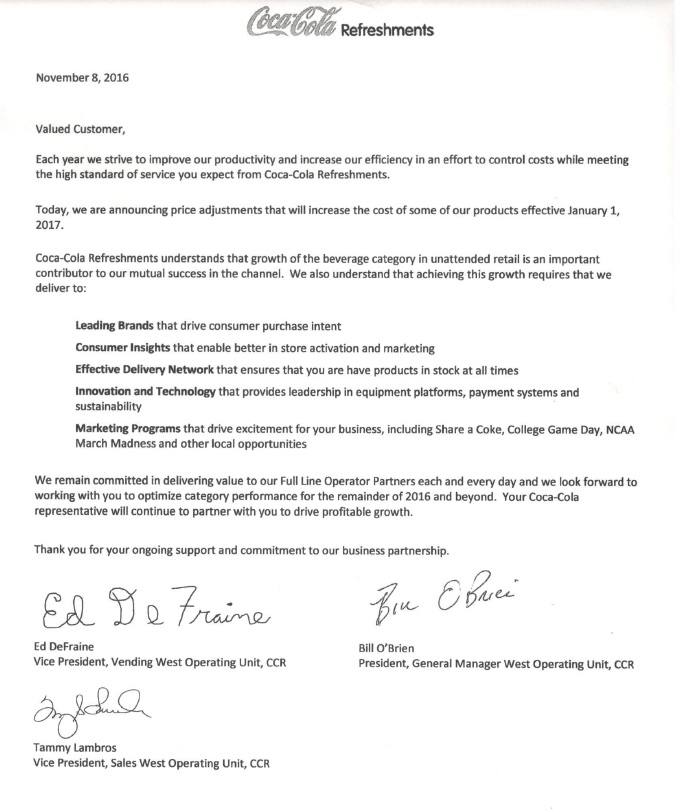Coca-Cola Refreshments achieves record low meaning ratio of 4%
If you have bad news, just come out with it. The more you bury it in self-serving bullshit, the more people will just think you’re a dishonest idiot. That’s what happened with today’s spectacularly opaque note from Coca-Cola Refreshments.
Here’s the note that J.D. Lowry of Las Vegas found on the break room soda machine.
Coca-Cola Refreshments
November 8, 2016
Valued Customer,
Each year we strive to improve our productivity and increase our efficiency in an effort to control costs while meeting the high standard of service you expect from Coca-Cola Refreshments.
Today, we are announcing price adjustments that will increase the cost of some of our products effective January 1, 2017.
Coca-Cola Refreshments understands that growth of the beverage category in unattended retail is an important contributor to our mutual success in the channel. We also understand that achieving this growth requires that we deliver to:
Leading Brands that drive consumer purchase intent
Consumer Insights that enable better in store activation and marketing
Effective Delivery Network that ensures that you are have products in stock at all times
Innovation and Technology that provides leadership in equipment platforms, payment systems and sustainability
Marketing Programs that drive excitement for your business, including Share a Coke, College Game Day, NCAA March Madness and other local opportunities
We remain committed in delivering value to our Full Line Operator Partners each and every day and we look forward to working with you to optimize category performance for the remainder of 2016 and beyond. Your Coca-Cola representative will continue to partner with you to drive profitable growth.
Thank you for your ongoing support and commitment to our business partnership.
Ed DeFraine Vice President, Vending West Operating Unit, CCR
Bill O’Brien President, General Manager West Operating Unit, CCR
Tammy Lambros Vice President, Sales West Operating Unit, CCR
Most vacuous communication ever?
Here’s what I think is going on here: Coca-Cola Refreshments is increasing the price of a can of soda.
The only meaningful words here to the customer are “We . . . will increase the cost of some . . . products effective January 1.” The rest is valueless (including the writers’ names, because really, who gives a crap).
That’s 10 meaningful words out of 246 for a truly bankrupt meaning ratio of 4%. That’s a record low for any communication I’ve analyzed.
The beverage consumer doesn’t care about success in the channel, consumer insights, marketing programs that drive excitement, or optimizing category performance. It’s sugar water with or without caffeine.
There is some unintended communication, though. This note says “We spend a lot of money making you want this soda, so we’re going to charge you for it — and in case you were wondering who we are, here are our names.” Honesty about your cupidity is not an effective communications strategy.
How this happens
Yes, there is something to learn from this — from asking “How did this happen?” Here’s what I think happened and what went wrong.
- Ed, Bill, and Tammy realized they were going to have to increase the retail price of sodas in their machines. They were worried about what people might thing of this.
- They decided to send a letter to their customers (the buildings and offices that host soda machines, not the people who drink the soda) and justify their actions.
- They put into that note all the things that are important to them — stuff like consumer research, vending machine technology, and advertising — because that’s how they justify the price increase.
- Somebody from the building put a copy of the note on the soda machine. (It’s possible that someone from Coca-Cola Refreshments posted the note, but that would be even stupider.)
The first two steps were ok, but the last two were mistakes. The writing here is centered on the writer, not the reader. The person who taped it to the machine was also failing to think. As a result, this note to communicates a completely different message: “We are raising the price, and we are clueless.”
A quick ROAM analysis tells you how to do this right
Imagine for a moment that you actually thought about this note first, using ROAM. Here’s what you’d find:
- Readers. The people who host the machines, not the end customers.
- Objective. Help the readers understand the price increase.
- Action. Customers will keep the machines around.
- iMpression: Coca-Cola Refreshments takes care of customers.
So you’d write this:
To the customer:
You’ll notice that some products will cost more starting January 1. Our costs have increased, so we needed to increase some of our prices.
We look forward to continuing to keep your machines stocked with popular refreshments.
Thanks. Ed, Bill, and Tammy.
As for the end-customers, say nothing. They don’t care about why the price went up, so don’t explain it.
Better to say nothing and be thought a fool than to open your mouth and remove all doubt.
Actual note below:

Even better would be:
Beverage buddies:
We raised prices January 1.
Maybe you’ll consume less sugar, as a result.
And that’s okay.
Here’s to your health,
Ed, Bill, and Tammy.
The people from the building may have posted the letter to deflect end-customer criticism of the price increase, in effect saying “Don’t blame us, folks, it was Ed, Bill, and Tammy.’